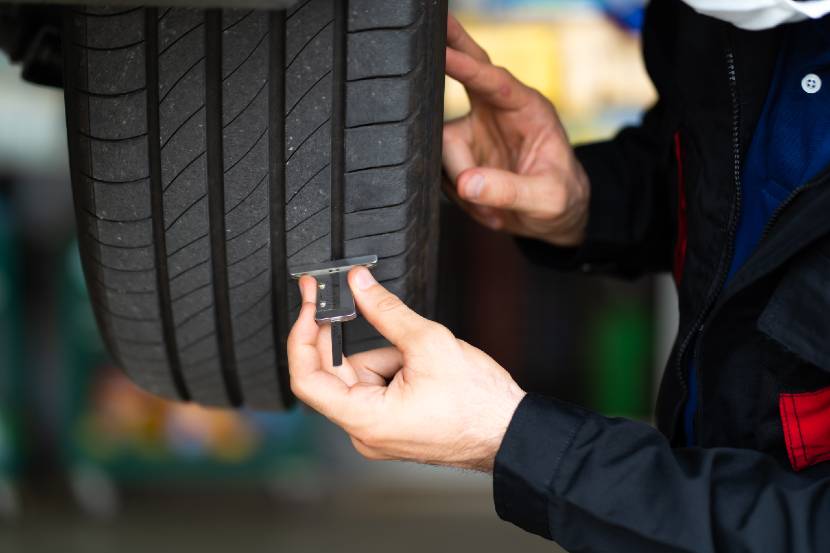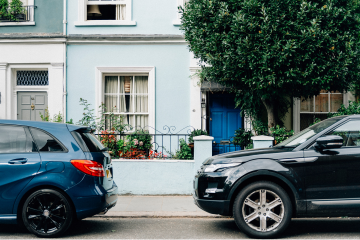There are 3 main checks for your tyres - the general condition, pressure and tread depth. It's worth checking your tyres before a journey and when they're cool. Here's what you need to know.

Checking your tyres
The 3 main tyre checks are:
How do I check the general condition of my tyres?
Take a good look around each of the tyres and make sure that there aren’t any:
-
Cuts
-
Tears
-
Bulges
-
Stones
-
Nails
-
Damage to the side wall
It's worth doing a quick check like this before every journey and a more detailed examination once a month. You should also check your tyres condition whenever you’ve bumped them on the kerb, or potentially damaged them in any other way.
You should also make sure you understand the various labels, markings and ratings on your tyres. If any of them don't meet the minimum standard, you might need to change your tyres.
How do I check tyre pressure?
Here's how you check your tyre pressure:
- Unscrew the valve cap on the tyre
- Attach the gauge firmly to take a reading
- If the reading is lower than the recommended pressure, inflate your tyres to match
- If it’s higher, let some air out
- When you’ve finished, take off the gauge quickly so no air escapes, and replace the cap
- Repeat on your other 3 tyres and your spare if its not a space-saver tyre.
You need to use a pressure gauge to get a measurement. You can buy one to use at home. Alternatively, petrol stations should have one that’s usually free to use.
It's a good idea to check your tyre pressure every month or before any long journeys. Make sure you check your tyre pressure when your tyres are cool, as that’s when you’ll get the most accurate measurement.
Where can I find the recommended tyre pressure for my car?
You should find the recommended tyre pressure for your car either inside the driver’s door or inside the petrol cap.
If not, check your owner’s manual or have a look online.
The recommended car tyre pressure is different for each car. There might also be different recommended tyre pressures depending on:
- The time of year
- The car’s load
Can I drive with the tyre pressure warning light on?
No - you should pull over as soon as its safe. Check all 4 tyres for a puncture and see if any of them look under-inflated.
A slow-puncture or underinflated tyre means that you have less grip and less control of the car. It's vital to check and fix any problem before it becomes dangerous.
How do I measure my tyre tread depth?
If you have new tyres, they should have a tread depth indicator. The legal minimum tread depth for cars is 1.6mm across the central three-quarters of the width of the tyre, and across the entire circumference. Once your tread gets this low, you must replace the tyre.
If you have older or more worn tyres, the easiest way to measure tread depth is with the 20p tyre test:
-
Place a 20p coin in the main grooves of the tyre.
-
If you can’t see the outer rim on the coin, then your tread depth is above the legal minimum.
-
If that outer rim is still visible your tyre tread depth could be too low. If this happens, it’s important to get them checked by a professional and, if necessary, replaced.
-
Make sure that you carry out the 20p tyre test in at least 3 different places along each tyre, as one part might be more worn than another.
To ensure your tyre tread depth always exceeds the UK legal minimum, consider doing the 20p tyre test at least every month. You should also check your tyres before going on any long journey.
Why is it important to measure my tyre tread depth regularly?
Your tyre tread is what helps keep you steady on wet roads. The tread channels water into the grooves of the tyre, giving you more control on the road.
The greater your tyre tread depth, the better the grip you have on the road. New tyres typically start off with an 8mm tread depth.
Once the tread starts to wear down, its road grip is reduced. This increases your braking distance and also the risk of skidding and aquaplaning.
Some manufacturers recommend that you replace your tyres after the tread goes down to about 3mm, as that’s when its performance starts to drop.
What happens if my tyres aren't legal?
If you’re caught driving on illegal tyres, you could be hit with a fine of £2,500 for each tyre and get 3 points on your licence.
So, if you had 4 illegal tyres, you could face a £10,000 fine and be disqualified from driving, even if you previously had no points on your licence. More importantly, you risk your safety and the safety of others.
If that’s not enough, you might also find any car insurance claim is invalidated if you have an accident while driving on illegal tyres.







